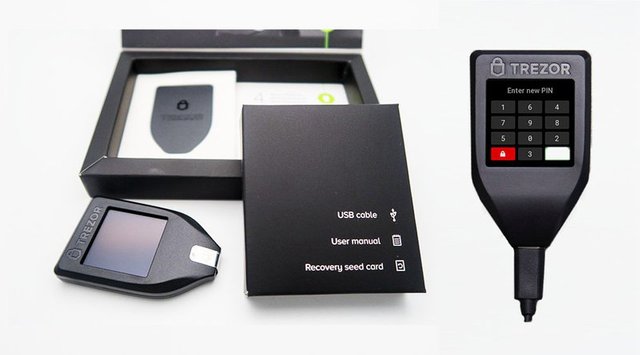We Tested the New TREZOR Cryptocurrency Wallet: This Is What We Found

The new TREZOR model T, a hardware cryptocurrency wallet developed by SatoshiLabs, is the second generation of SatoshiLabs’ popular TREZOR hardware wallet family. The Model T was announced in November 2017, on the ninth anniversary of Satoshi Nakamoto’s Bitcoin white paper and made available for pre-order. All pre-order devices were sold out, and regular sales are expected to start soon.
Bitcoin Magazine has tested a TREZOR Model T. The matchbox-sized device comes in a sleek package with a USB-C cable for connecting to a computer or phone; stickers and other accessories; and a minimalist Post-it-sized “Getting Started” guide. An online guide titled “Getting started with TREZOR Model T” provides more detailed instructions with pictures.
The device is only powered when plugged in and connects to the blockchain via a web interface through the host computer. Contrary to previous TREZOR models with buttons, the Model T has a touchscreen. Other differences include a new version of the firmware, TREZOR Core, which has been written from scratch. The source code for TREZOR Core is available on Github, with other TREZOR software.
The new device also comes with a magnetic dock that can be affixed to any firm surface. The Model T can then be attached to the dock by means of magnets embedded in the device.
We plugged the device into a computer and followed the instructions in the online guide, which direct the user to open a supported browser and go to the TREZOR web interface. Once the firmware was correctly installed, we went on to create a new wallet.
The web interface gives step-by-step instructions, synchronized with instructions that appear on the device’s screen.
After generating a new wallet, the user should immediately follow the instructions to create a backup in the format of a personal recovery seed. The Model T generates a unique, 12-word long recovery seed, which is displayed on the device screen. The user should write down the seed words on a recovery card (there are two recovery cards in the box, in case one is lost). Then the device randomly selects two words and asks the user to retype them on the screen for verification.
The 12-word seed permits recovering the content of the wallet in case, for example, the device is damaged or lost, and it is the only way for the user to do so. Of course, malicious parties could do the same. Therefore, it’s very important to follow the recommendation: “Remember to keep your card with the seed words in a safe location and never store it as a digital copy. We strongly discourage you from taking photos of your recovery seed or to make any digital copies. Please do not write down the words into a text file on your computer, even if your computer is encrypted.”
The next step is naming the device and choosing a numeric pin code by using the touchscreen on the device. An essential security feature of this step (that some might find annoying) is that the layout of the numeric keypad on the touchscreen changes at each input.
Now, the TREZOR T is ready to be used by simply plugging it into a computer (if the computer doesn’t have the TREZOR Bridge software and driver installed, those must be installed first), authenticating with the pin code, and using the web interface. The web interface and the on-screen interface on the TREZOR T work smoothly in tandem, and, often (for example, when sending funds), the information entered via the web interface must be confirmed on the device.
Besides Bitcoin, the TREZOR T supports Bitcoin Cash, Bitcoin Gold, Dash, Litecoin, Zcash, Ethereum and Ethereum Classic; both versions of Ethereum are supported through a partnership with MyEtherWallet.
We tested the TREZOR T as a bitcoin wallet. First, we sent bitcoin from external wallets, in multiple transactions, to a new bitcoin address generated by the TREZOR T. Then, we sent bitcoin from the TREZOR T to external wallets. All transactions went through without problems and appeared in the transaction list in the web interface.
When the TREZOR T is unplugged, it powers down and disconnects from the internet. Therefore, the user’s funds stored on the device are safe and beyond reach of thieves, making this hardware wallet a secure, matchbox-sized, cryptocurrency “bank.” Of course, it’s important to store the device (and in particular the cards with the seed words) in a safe place — or even better, in separate locations.
In summary, the TREZOR T is useful and usable. Perhaps the initial set-up procedure is a bit complicated for users without a minimum of computer expertise, but most users of hardware cryptocurrency wallets are likely to be able to, for example, install drivers manually if needed by following the clear instructions in the user guide. After the initial set-up, the TREZOR Model T seems very easy to use, with an appealing UI and cool new features.
Disclaimer: SatoshiLabs provided Bitcoin Magazine with a free TREZOR Model T to use for the purpose of testing their product for review.
 #Cryptocurrency #bitcoin #blockchain #ethereum #news #blog #steem #steemit #ico
#Cryptocurrency #bitcoin #blockchain #ethereum #news #blog #steem #steemit #icoPosted from my blog with SteemPress : http://cryptonewsdesk.ga/2018/03/16/we-tested-the-new-trezor-cryptocurrency-wallet-this-is-what-we-found/